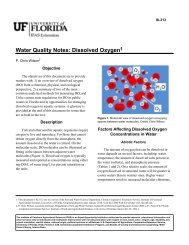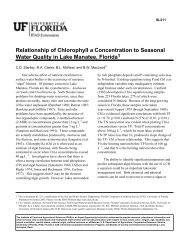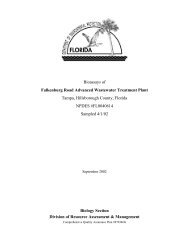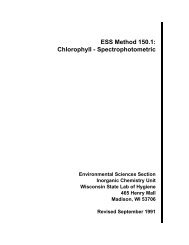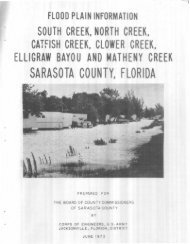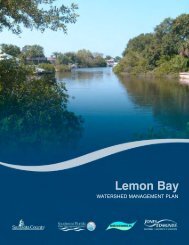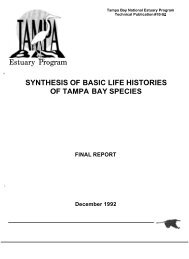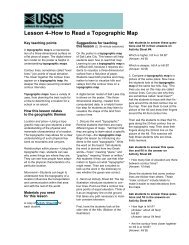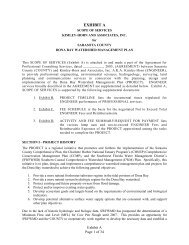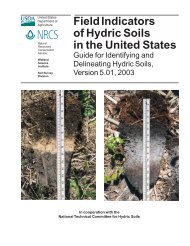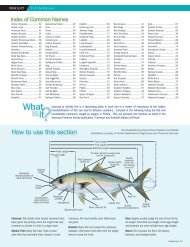Peace and Myakka River Water Quality Summary 2002 - Southwest ...
Peace and Myakka River Water Quality Summary 2002 - Southwest ...
Peace and Myakka River Water Quality Summary 2002 - Southwest ...
You also want an ePaper? Increase the reach of your titles
YUMPU automatically turns print PDFs into web optimized ePapers that Google loves.
Median color values for Florida rivers <strong>and</strong> estuaries, as reported by Friedemann <strong>and</strong>H<strong>and</strong> (1989) based on a survey of several thous<strong>and</strong> records retrieved from the U.S.EPA STORET database, are 70.0 <strong>and</strong> 20.0 pcu, respectively. Values observed in thetidal reaches of the <strong>Peace</strong> <strong>and</strong> <strong>Myakka</strong> river systems during water years 1994-2000(Appendix B) were substantially higher than these statewide medians.Near-Surface TSSConcentrations of total suspended solids (TSS) reflect levels of organic <strong>and</strong> inorganicparticulate matter present in the water column. High levels of TSS can impact thequality of aquatic habitats by reducing water clarity <strong>and</strong> light penetration, thus affectingthe growth of algae <strong>and</strong> rooted aquatic plants. Areas of high TSS deposition <strong>and</strong>resuspension are often sub-optimal habitats for many aquatic organisms, due to fouling<strong>and</strong> smothering effects <strong>and</strong> reductions in dissolved oxygen availability that can occur asa result of elevated sediment oxygen dem<strong>and</strong>.Annual median near-surface TSS values in the tidal <strong>Peace</strong> <strong>and</strong> <strong>Myakka</strong> river samplesranged between 3 <strong>and</strong> 36 mg/L, with the higher values occurring at the moredownstream stations (Appendix B). Median values for Florida rivers <strong>and</strong> estuariesreported by Friedemann <strong>and</strong> H<strong>and</strong> (1989) are 7.0 <strong>and</strong> 17.5 mg/L, respectively. With theexception of relatively high values observed at several stations during the 2000 wateryear, TSS concentrations at the tidal <strong>Peace</strong> <strong>and</strong> <strong>Myakka</strong> <strong>River</strong> monitoring sites do notappear to be elevated with respect to other Florida water bodies.Near-Surface TurbidityTurbidity is an expression of the optical property that causes light to be scattered <strong>and</strong>absorbed rather than transmitted in straight lines through a water sample. It is primarilycaused by suspended matter (e.g., clay, silt, <strong>and</strong> finely-divided organic <strong>and</strong> inorganicmaterials), soluble colored organic compounds, <strong>and</strong> plankton <strong>and</strong> other microscopicorganisms (APHA 1989).Annual median values measured at the tidal <strong>Peace</strong>-<strong>Myakka</strong> monitoring stations duringwater years 1994 - 2000 ranged between 1.7 <strong>and</strong> 7.3 NTU, with the highest valuesoccurring at the most upstream stations on both rivers (Appendix B).Turbidity measurements can be affected by high levels of water color, apparently due tolight absorption by the dissolved substances that are also responsible for color (APHA1989). Because the tidal <strong>Peace</strong> <strong>and</strong> <strong>Myakka</strong> are highly colored river systems,comparisons of turbidity measurements from these areas with measurements fromother rivers, with different color characteristics, should be done with caution.53



